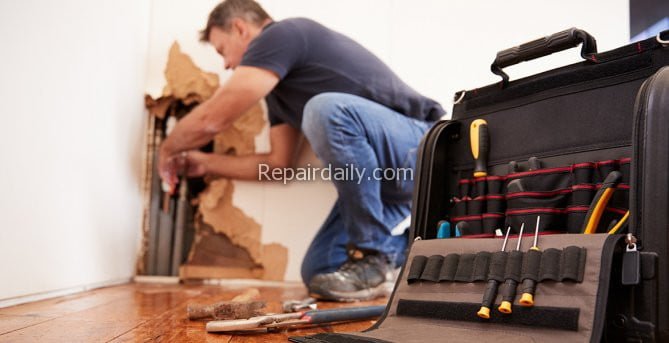
A home or business that suffers water damage must be restored as soon as possible. Understanding the science behind a job is critical to its success and safety. Throughout this article, we discuss the various aspects of water damage restoration, including assessing the extent of the damage, implementing mitigation strategies, and restoring your property.

The Science of Water Damage
A mitigation strategy is developed based on the level of water damage. Water intrusion is identified and evaluated based on the source and severity. Professionals use moisture meters and infrared cameras to detect excessive moisture. They use this data to restore the damaged materials to determine the best course of action.
Different factors can lead to water damage, such as flooding, pipe bursts, and leaky roofs. Whenever water seeps into materials such as drywall or wood, it causes the materials to swell and rot. As water sits in the material for an extended period, damage to the material becomes more severe. Understanding how quickly these materials will deteriorate when exposed to moisture is essential when restoring them.
After addressing the levels of water damage, it’s important to implement proper mitigation strategies to prevent further damage and restore your property to its pre-damaged state. Removing standing water with pumps and vacuums, disinfecting contaminated surfaces with chemicals, and using dehumidifiers to reduce humidity levels in the area. Additionally, professionals can use physical barriers such as tarps or other waterproof materials to block moisture from entering a space again.
Understanding the Restoration Process
Water damage restoration is a multistep process that begins with assessing the extent of the damage and providing an estimate for repair. It involves inspecting the affected area to identify any structural, mold, or other issues caused by water infiltration and identifying any hazardous materials that may have leached into the air or environment. Professionals will use special tools such as infrared cameras and moisture meters to assess moisture levels in walls, ceilings, and floors.
Mitigation strategies are implemented based on the damage level determined in the assessment to prevent additional damage and return your property to pre-damage condition as soon as possible. These might include removing standing water with pumps and vacuums, disinfecting contaminated surfaces with chemicals, using dehumidifiers to reduce humidity levels, and installing physical barriers such as tarps or other waterproof materials to block moisture from re-entering the space.
Replacing damaged material is a crucial part of the restoration process. It’s important to use specialized equipment to restore water damage. It might include high-powered fans to dry wet areas more quickly, industrial-grade dehumidifiers to reduce humidity levels, and specialized vacuums to remove standing water. Professionals will also use personal protective equipment (PPE) such as boots, gloves, goggles, face masks, and respirators to protect themselves while they work in potentially hazardous environments.
Drying techniques used in water damage restoration
Drying techniques remove excess moisture from affected materials after water damage restoration. The goal is to restore the affected material to its pre-damaged state as quickly and efficiently as possible. Understanding the science behind drying techniques is important to complete water damage restoration projects.
The science of drying techniques
Understanding how water moves through different materials is key when drying out wet materials properly. Water moves through evaporation, condensation, and absorption. A liquid evaporates into a gas, which disperses into the atmosphere; a gas condenses to become a liquid, and a material absorbs moisture from another. Before figuring out the best-suited techniques, it’s important for one to understand the material absorption and resistance.
Different drying techniques
Air circulation is one of the simplest drying methods, while specialized equipment is another. You can use fans or open the windows for the quick and easiest way to dry wet materials.
Dehumidifiers also reduce humidity and remove water vapor from the air. The drying process may also be sped up by powerful fans, vacuums, and other equipment professional water damage restoration companies use. Sometimes, using the right technique based on the materials and conditions is important.
Dehumidification for water damage
Water damage restoration requires dehumidification. The drying process of wet materials is more effective in an environment with lower humidity levels. Dehumidifiers collect and dispose of air moisture. Moreover, it reduces mold growth, which harms your health and property.
Additionally, dehumidifiers help to ensure that materials affected by water damage don’t become damaged beyond repair due to continual exposure to excess moisture in the air.
As such, dehumidification plays an important role in restoring space to its pre-damage state quickly and safely. As discussed earlier, it is also important to use drying techniques to ensure that all materials affected by water damage are dried properly. By following the steps outlined in this blog, it will be possible to successfully restore any space damaged by water and return it to a safe, healthy state.
Secondary Damage Following Restoration
Secondary damage occurs when water or moisture causes additional damage to materials not initially affected by the water source. Secondary damage is also a result of improper drying of wet materials, flooding, leaks in ceilings and walls, and more. During the water restoration process, it is important to prevent secondary damage.
To avoid secondary damage, acting quickly after any water incident is essential. The sooner you act and begin the restoration process, the better chance you have of preventing further damage from happening. Be sure to use drying techniques, such as air circulation and dehumidification, to ensure that all wet areas are dried properly.
Final Considerations for Water Damage Restoration
Understanding the science of water damage restoration is key to successfully restoring any water-affected space. Different materials respond differently to other drying techniques, so knowing which works best for each material is important. Additionally, using dehumidifiers and removing all sources of moisture are essential steps in the process. Finally, taking preventative measures such as quickly and properly drying wet areas can ensure no secondary damage occurs following restoration.
